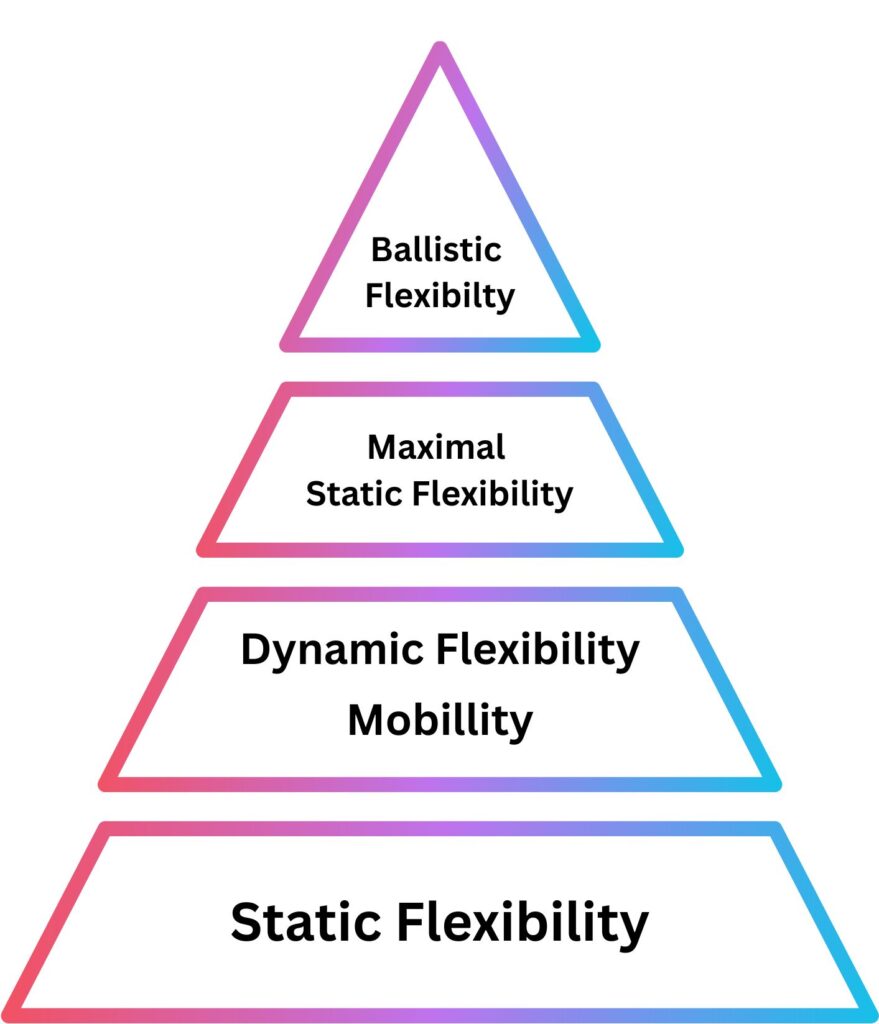Periodisation of Flexibility
Introducing the Flexibility Training Pyramid
In resistance training, the strength training pyramid is often used as a fundamental concept underlying specific strength development overtime. It starts with foundational qualities like muscular endurance and stabilisation, and builds toward peak expressions of strength such as power and speed-strength. This hierarchical structure serves as a roadmap for designing an effective periodised training program to develop sports specific strength.
The same philosophy can be applied to flexibility.
The Flexibility Training Pyramid below outlines a clear, progressive path for developing sport-specific flexibility. Just like in strength training, building a strong foundation is key to unlocking more advanced, dynamic capabilities at the top of the pyramid.
Before we dive deeper, we recommend reviewing our article on Types of Flexibility to give you helpful context for what follows.

Let’s Examine the Pyramid Layers and Why This Progression Works
1. Static Flexibility – The Foundation
At the base of the flexibility pyramid is Static Flexibility; the range of motion (ROM) you can achieve passively at a joint or group of joints. Without a base level of static flexibility, your ability to move efficiently or explore more advanced flexibility methods becomes limited. When ROM is lacking, the body tends to compensate taking the path of least resistance, often leading to inefficient or unstable movement patterns. Whether you’re performing a squat in the gym or sprinting on the field, every basic movement requires adequate ROM at specific joints. Building ROM at a static level first is the safest and most effective starting point.
2. Mobility – Controlled Use of Your Range
Mobility refers to your ability to actively control your range of motion, not just passively hold a position. This is why mobility follows static flexibility in the pyramid. Without first establishing a baseline passive range, there’s nothing to mobilise. You can’t control a range you don’t yet have. Static flexibility gives you access; mobility teaches your body how to use it.
Mobility is required for everyday tasks like reaching overhead or getting up from the floor. In the gym mobility enables you to squat, hinge, push, pull and rotate with ideal biomechanics. Once this active control is in place, you have a dependable platform from which to develop sport-specific strength, speed, and agility more safely and efficiently.
3. Dynamic Flexibility – Moving Through Full ROM
Dynamic flexibility is a progression from mobility. It involves moving through your full range of motion in a controlled, deliberate manner, think high kicks, lunges with rotation, or a sprinter’s stride. This level of flexibility is more demanding, as it tests both your range and your ability to control that range under speed or load. Without sufficient static flexibility, attempting dynamic work is like trying to push a heavy load uphill, tightness and resistance from underprepared tissues will limit your range and fluidity. By training full-range movement under control, dynamic flexibility lays the groundwork for high-level expressions of flexibility seen in advanced athletic performance.
4. Maximal Static Flexibility – Pushing the Limits
Maximal static flexibility isn’t required for all athletes, but it’s essential in sports like gymnastics, dance, cheerleading, and figure skating, where athletes push beyond typical joint ranges. Achieving this level requires long-term, consistent training, often starting early in life.
Maximal flexibility training is proposed to create plastic changes in the musculotendinous unit, meaning your tissues actually adapt to allow for more range. This kind of development must be carefully built on a static and dynamic base before introducing more aggressive methods like ballistic work.
5. Ballistic Flexibility – Explosive Use of Range
At the top of the pyramid is Ballistic Flexibility; the ability to move explosively through your range of motion using momentum. Think of split leaps, high speed throws, or dynamic aerial actions such as high jump in athletics. This type of flexibility places high demands on the muscles, tendons, and joints. Unlike dynamic stretching, which is typically performed with control, ballistic flexibility involves rapid, bouncing, or swinging motions, making it more intense and inherently less controlled.
Ballistic flexibility should only be introduced once a strong foundation of static, mobility, and dynamic flexibility has been developed. Without adequate tissue compliance and preparatory range work, ballistic movements increase the risk of strain or injury.
Bringing It All Together
The Flexibility Training Pyramid offers a structured framework for developing sport-specific flexibility in a progressive, purposeful way. Just like in strength training, building a solid foundation first reduces risk and enhances long-term performance outcomes.
While we’ve broken each layer down separately to help you assess where your current focus should lie, it’s important to understand that flexibility development isn’t always strictly linear. With the right approach, you can continue improving multiple aspects of flexibility at once, as long as they’re programmed appropriately for your goals and your body’s readiness.
Understanding your current capacity and training needs allows you to train smarter, not just harder. Whether you’re working to unlock deeper ranges, control movement more effectively, or prepare your body for the demands of high-performance sport, flexibility should be part of your long-term strategy.
Ready to Take the Next Step?
If you’re unsure where to begin, or you’re ready to train with more direction, we’d love to support you.
👉 [Book an Initial Consultation & Movement Assessment]
👉 [Get in touch to discuss our flexibility programming or educational workshops]
